|
Bank on it...
Shane Conroy, Asst Supt, Park Ridge Country Club, Park Ridge, IL:
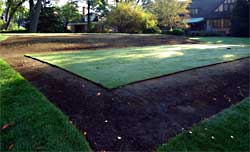  "The tee bank on hole nine was stripped and resodded this week. Most of the grass on the bank surrounding the tee box was bentgrass; because of this we stripped a fair amount of sod around the existing tee and resodded using Kentucky bluegrass. The tee now has a straight, defined edge."
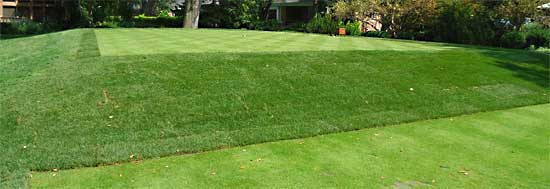
Visit the Park Ridge blog at parkridgeccgrounds.blogspot.com/.
|
 |
|
Green Edges...
John Temme, The Wakonda Club, Des Moines, IA:
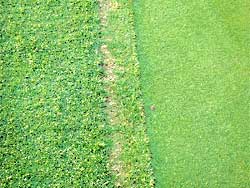
The edge of 12 green. We will reduce the mowing height of this turf down slowly over time until we are back to regular greens mowing height.
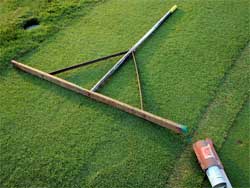
The tool we use to measure the width of the collar. We use the outside edge of the collar as a reference point because we have a distinct edge when two different species meet (Kentucky Bluegrass & Creeping Bentgrass.) We paint small green dots around the edge of the green to keep the mowers where they need to be.
|
 "You may have noticed that some of the green edges have been recently scalped off. This was not by accident. When mowing the cleanup lap (the circle around the outside edge of the green) it is very difficult to get the edge in precisely the same spot time after time. Say; for example, the cleanup is mowed a mere 1/8 of an inch off the edge of the collar- doesn't sound too bad, right? Multiply 1/8 inch by 3 cleanups per week times 20 weeks = 7.5 inches! For this reason we have a measuring tool which we use to keep the green and collar consistent over time.
Why did we get so far off? One of our best cleanup mowers did not return to the maintenance staff this year. We are left with only two men who truly do a perfect cleanup every time. It is a skill that requires a very steady hand and is difficult to master even with years of experience. Add to this employee vacations and we got off track. Also, this spring we had several large projects which diverted the skills of our talented and experienced staff members. Modifications made to #17 and Lower #2 took experienced workers weeks to complete."
Visit John's blog at wakondagrounds.blogspot.com.
|
 |
|
A Look At Our Operation...
Sean McCue, Country Club at Castle Pines, Castle Rock, CO:
 "A couple of weeks ago we shot a video that is being done for the club's website that shows my staff in action as well as explaining our current green renovation project.
This video gives great information about our operation in addition to explaining the detailed steps involved in the renovation process of the putting green. These steps are explained and also insight is given as to why we are trying to eliminate Poa annua from our greens.

The company that is doing our video production is called Oswego Creative and they do great work."
Visit Sean's blog at cccpgcm.blogspot.com.
|
 |
|
The grubs are grubbing...
Tim Anderson, CGCS, Naperville (IL) Country Club:
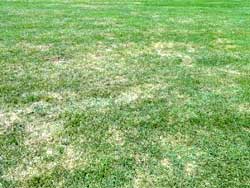  "Some areas in the rough are beginning to show evidence of grub worms feeding on the roots of the plant. Greens, tees, fairways and the rough around the fairways is treated to prevent damage. Most of the rough is not treated due to it being cost prohibitive to make an application across all of the rough. The brown spots (in the picture) around healthy green grass is a typical sign of grubs feeding.
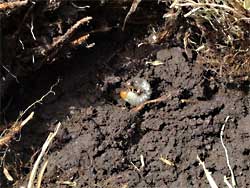
These grubs will feed on the roots this fall before burrowing deeper into the ground when cooler weather sets in. They will overwinter in the ground as grubs. As temperatures warm in the spring, they will return to the surface and prepare for their pupation stage before emerging from the ground as adults in June and July. They mate, and lay eggs which hatch and begin to feed on the roots in August and start the cycle over again.
The worst of the areas is by the red tee on 13.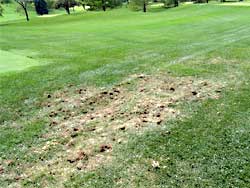
Though the roots are damaged, the majority of this disruption was caused by a skunk or raccoon scraping the turf while preying on the grubs. The areas that we have found have been treated with a product that will kill the grubs. We suspect more areas to show as the days go on. We will continue these applications as new areas are scouted. Most of the damaged areas will come back after the grubs stop feeding. This spot at 13 red tee will require some seed this fall for a full recovery."
Visit Tim's blog at napervilleccgrounds.blogspot.com.
|
 |
|
Aeration: A breath of fresh air for turf!
Jason Hooper, Quilchena Golf Club, Quilchena, BC:
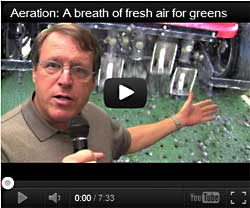  "Yes, it's that time of year again. The time of year that every golfer looks forward to most.....AERATION!!! Okay, obviously I'm being sarcastic, but once again it's part of my job to help you better understand exactly why it is so important that we aerate. So since I've written numerous blog articles doing just that, I figured I'd let you hear from another industry professional this time around. So without further adieu, grab some popcorn and sit back and enjoy!
Here's what to expect with regards to course conditions following the late-summer aeration:
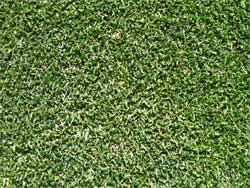 Greens will be sandy, bumpy and slower as they heal from the aeration. How quickly they heal is very much dependent on weather, but we do help them along with timely fertilizer applications and by temporarily raising the height-of-cut. They will always heal quicker following the late-summer aeration vs. the spring aeration as air and soil temperatures are much warmer in this time of year. You can expect them to take 10-17 days to return 'back to normal'. The photo above right shows what they looked like just 6 days following the late-summer aeration last year.
Tees will be sandy for 14-21 days following aeration while the topdressing works into the turf canopy. They will also be heavily over-seeded so you can expect to see lots of new turf germinating and growing on them soon. Tees should be back to normal within 14-21 days.
Fairways will be quite shaggy for 10-14 days following aeration since our mowing frequency will be reduced as they recover. They will also be sandy as the topdressing works into the turf canopy. They should be back to normal within 14-21 days.
Roughs will be deep-tined with solid tines and topdressed. Some high-traffic areas in the rough, mainly at green and tee complexes, will also be deep-tined. You can expect sandy rough for 14-21 days following aeration.
FINGERS ARE CROSSED FOR GOOD WEATHER!"
Visit Jason's blog at qgolfclub.blogspot.com
|
 |
|
Lake bank mowing...
Paul L. Carter, CGCS, Bear Trace at Harrison Bay Golf Course, Harrison, TN:
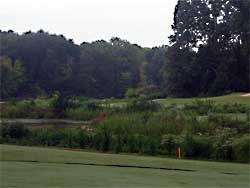  "The Bear Trace at Harrison Bay is located on a beautiful peninsula which extends out into Harrison Bay. It has eleven holes which touch water and these waters are regulated by the Tennessee Valley Authority which dictates how we can maintain the banks around the lake. We use buffer strips around the golf course to filter fertilizer and chemical residues as well as restricting possible soil particles from running off into the surface water.
We have several holes which play across the water from the tee and occasionally the vegetation grows high enough as to impede the play of the hole. This is a big problem for us because TVA restricts our ability to place any equipment near the waters edge or apply any chemicals or growth regulators in these areas. It is times like this when having friends with the proper tools to do the job comes in handy.
The Tennessee Department of Transportation, TDOT, has been very helpful this week by bringing one of their reach arm right of way mowers out to the golf course to safely and properly maintain the lake banks without damaging the lake bank or endangering the environment.
The mower is capable of remaining a safe distance from the waters edge and mowing the vegetation down to an acceptable and safe height. The work this machine can do in a day would take weeks and weeks for my employees to do by hand.

When all is said and done the high vegetation is removed allowing a clearer view of the hole, while protecting the stability and structure of the lake bank and observing the rules and regulations by which we are bound. Many thanks to our friends at TDOT and job well done."
Visit Paul's blog at bthbgcm.blogspot.com.
(Editor's Note: The Bear Trace at Harrison Bay is a State of Tennessee property.)
|
 |
|
Where are the divot boxes?
David Brandenburg, Rolling Meadows Golf Course, Fond du Lac, WI:
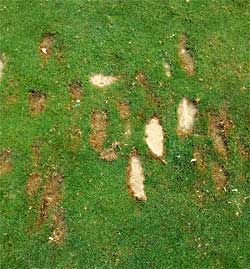
In this picture taken after a high profile event with local players only four of more than 45 divots were filled. (I couldn't capture all 45 divots in the camera.) And it looks like one person filled the three because they are right next to each other.
|
 "You may have noticed we picked up the Divot Boxes on the tees this week and yes, it is a little earlier than normal. In past years we have waited until late September to do so with the hopes that customers would use them. Hopefully you noticed because you went to fill a divot and the box wasn't there but I fear it is because you went to sit on the box or throw your garbage in it!
Well the hope is over. I have watched the tees with divot boxes closely this year and it did not matter if we had daily play, juniors, seniors, member tournaments or even a WSGA Tournament, less than 10% of the divots on a par 3 were filled. Often I would have 3 or 4 filled divots spaced between 40 to 50 empty holes. How can a member of the club take a gully like that and then not fill the divot when the box is right there?
"Hopefully you noticed because you went to fill a divot and the box was not there but I fear it is because you went to sit on the box or throw your garbage in it!" |
After seven years of investing in nice divot boxes and all the thanks in the world to the customers who use them religiously do we really need them out there? For now they are just gone for fall as our staff shrinks by over half this week and we do not need to invest important labor hours in moving the unused divot boxes every time we move the markers. We are considering not even putting them out next year and just reinvesting the time we spend moving the boxes in more important jobs. I hate to let the golfers off the hook but right now we send teams of divot fillers out every 10 days or so to fill all the par 3 and heavy use par 4 tee boxes anyway.
Again, we appreciate all of you who do fill divots and the bottles will still be available on the carts so you can do so. I also appreciate all the people who fix their ball marks but if every person who told me they fix three or four per green actually did, we would not have any left. But that is a story for a different day..."
Visit David's blog at rmgc-maint.blogspot.com.
|
 |
|
About our Blog Aggregator: Many superintendents are now hosting private blogs to better communicate with their golfers and/or members. Beyond local weather and course conditions, there is a great deal of information about projects, methodologies and techniques that would be of value to other superintendents — hence our Turf Blog Aggregator. As every blogger struggles occasionally with content, we also include posts intended to educate golfers about turf maintenance for others to use as a template for their own blogs.
Miss any previous issues of TBA? You can find them all here.
Turf Blog Aggregator(TM) is a trademark of Turnstile Media Group.
|
|